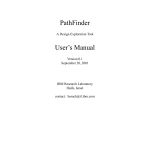Download With some careful forethought, the design of feature
Transcript
F E A T U R E M U L T I L A Y E R S W I T C H D E S I G N When Network Design Meets Chaos Theory With some careful forethought, the design of feature-laden multilayer switches doesn’t have to be an exercise in chaos management. By Michael Orr s designers know all too well, development of stable, fullfeatured networking products is becoming increasingly difficult, because of the alarming pace at which the complexity of these devices is growing. This “complexity explosion” is a result of ever-expanding standards, protocols and applications, used to address the evolving functions like quality-ofservice, virtual local-area networks (VLANs), virtual private networks and policy enforcement that networks are being asked to deliver. All of those changes greatly affect the code that runs network devices, which must constantly be updated with the latest and greatest IEEE or IETF standard—even as it is being ported to the next generation of switching silicon. Given that situation, it is not surprising that the specifications of these multilayer switches typically comprise a long, growing list of features and functions that have to be implemented, greatly increasing the time spent on feature implementation, integration and verification. To meet this growing challenge, implementation teams typically adopt a modular approach, where each feature or group of features is treated as a separate subproject (see Fig. 1), and is integrated into a whole in the final stages of development. This time-honored method allows several tracks to be worked on in parallel, and allows some (if not all) of the A required modules to be acquired—from either open-source projects like Linux or commercial vendors. This mix-andmatch methodology fits with the view of the product as a collection of features. Unfortunately, that approach misses the system-level implications, which have a greater impact on device functionality and integrity than any particular feature. This article will explain some of the system-level aspects that require special attention when multilayer switches are designed and implemented. There are many aspects to a multilayer switch that are not related to any particular feature, and many aspects that should be associated with all features. These will typically be infrastructure facilities that should be designed separately, before any feature is implemented, and should form a coherent framework that will host all features, including future functionality. While a complete discussion of those aspects is beyond the scope of this article, some examples may illustrate the point. Resource usage (RAM, interrupts, semaphores, flash, UART, etc.): Every device has a limited set of resources that is shared by all subsystems and modules. Allocation of those must be planned centrally, with special attention given to extreme cases. For example, how much RAM will a table occupy? What will happen if all 4,096 VLANs are active? In some cases, the way resources are handled may be significant: Are all interrupts disabled, or just the lower-priority ones relative to the module currently running? Is flash memory written sector by sector or file by file? Resource arbitration must be part of a systemwide design and cannot be done on a per-module basis (especially for imported code), where each source may have a different set of assumptions about available resources and their usage. User interfaces (CLI/WEB/SNMP-based GUI/Telnet): Almost every feature has attributes that are, and sometimes must www.CommsDesign.com FEBRUARY 2003 COMMUNICATION SYSTEMS DESIGN 25 F E A T U R E M U L T I L A Y E R be, user-configurable. Users expect to be able to assign parameters, set limits and view information through a single, uniform interface, even if underlying features have nothing to do with one another and can be separately implemented. Even when several ways of achieving the same purpose are available, all interfaces are expected to be synchronized and provide the same functionality. Clearly, this is not something that can be done on a per-module basis. ■ Implementation choices During design, difficult choices must be made about how to use the resources of the powerful switching ASICs at the unit’s heart. Trade-offs abound. An implementation method that is suitable for one feature may make implementation of some unrelated feature more complicated or even impossible. For example, typical switching silicon is composed of packet processors with multi-Gigabit Ethernet ports and “fabric adapter” chips, which interconnect the processor into larger systems—assisted by such system components as memory, flash and CPU. While the chips are an engineering feat—able to carry out complex operations on passing frames at wire speed—they are essentially a collection of empty decision tables. To make matters worse, the various decision tables have subtle interdependencies such as “If table X is used, then table Y can’t be used,” or “must be used”. It is up to the implementer to choose which decision tables are appro- S W I T C H D E S I G N priate and in what way they should be used, as well as ensure that this is done in a consistent manner. There is also an inherent gap between the specification and definition of the desired functionality (as defined by Internet Engineering Task Force RFCs) and the available chip mechanisms used to implement them. For instance, the IETF DiffServ standard, which comprises several RFCs, defines “per-hop behaviors” and a Management Information Base (MIB) control language used to express the desired configuration. The chip typically has none of that. In- Difficult choices must be made about how to use the powerful switching ASICs at the unit’s heart. stead, it provides general classifiers, various counters, queues and queue-scheduling algorithms —none of which is even hinted at in the IETF standard. It is up to the implementer to use chip facilities to implement or at least approximate the desired high-level definition. ■ Internal interfaces Many modules feature internal interfaces that tie them into common infrastructure elements. If the modules originate from different sources or are implemented independently, those interfaces must be defined in advance, to suit all features—with thought given to 26 COMMUNICATION SYSTEMS DESIGN FEBRUARY 2003 www.CommsDesign.com future requirements and changes. For example, if several modules generate instructions to be placed into the general Internet Protocol (IP) forwarding table, the routing table must be designed to store data for all cases. It must also synchronize and coordinate possibly conflicting updates arriving in random order from multiple sources. Now add to that some facility to account for future routing protocols like BGP4 and IS-IS to be added or the ability to handle equal-cost, multipath forwarding, and forwarding of Multicast traffic, and you begin to see why the routing table and its update mechanism can’t be designed on a permodule basis. A similar case can easily be made for the SNMP interface. As virtually all data communication devices are expected to implement SNMP and a large collection of standard and private MIBs—databases that describe device status in minute detail—all features must be represented, and may manipulate those databases in a variety of ways. If each module has its own idea of how this should be handled, chaos is sure to follow. ■ Future proofing designs While it is certainly possible to solve all of the issues mentioned above in an ad hoc manner and create a device from modules built or acquired from multiple sources, the result is typically “quick and dirty,” and makes subsequent changes and additions harder and harder. A systematic design can accommodate inevitable future additions and changes more readily than a sum-of-parts approach. While it’s certainly not the only solution on the market that employs a systematic approach, the OpENS software architecture (see Fig. 2) clearly illustrates a few tricks of the trade that can be employed to keep a product from becoming “brittle” as it ages. From experience, we’ve learned that some items that can be expected to change are as follows: Switch ASICs: Whether it’s a slight revision to the currently used chip set or a whole new generation of switch ASIC, the new silicon will typically have different capabilities that must be accounted for in software. Segmenting the software into a VLSI-dependent module (see Fig. 2 again) addresses part of the challenge, F E A T U R E M U L T I L A Y E R but other issues remain. For example, even some of the more subtle changes, like per-port instead of systemwide scheduling settings, may represent major operational differences. Also, some might add the ability to handle MPLS frames as well as IP. How much of the code will have to be rewritten? Service configurations: If a product is successful, it is certain that similar-butdifferent configurations will be required—more ports, chassis and/or stackable versions of standalone switches— and standalone versions of stackable ones. What will be required to implement those variations? Man-machine interface (MMI): Changing user requirements mean that new control elements need to be added to the system, and new information may have to be collected and displayed. This should be taken into account, so that it will not be necessary to go over each and every feature and modify it separately. For example, suppose the CLI syntax and or semantics need to be modified—how extensive will the effect be? Suppose the user adds remote authentication to the usual local user name/password database. Will every feature have to be modified? Even with this small sampling of issues, it’s apparent that you can’t implement functions and features piecemeal without inviting disaster. Remember, before the first feature is implemented, a good deal of systems-level design is required to create a consistent framework to accommodate it. But is this enough? Of course not! ■ When features collide Now we will see how features that seem to work separately interact in surprising ways when combined. An important point to note is that while most of these surprises can, in theory, be foreseen, they are typically discovered the hard way, no matter how knowledgeable the design team may be. So, experience counts for a lot. A comprehensive “What to watch for” list cannot be provided here, but the examples cited below are instructive. So let’s look at some examples along the general theme of chip/hardware dependencies and side effects. Scheduling methods: Typically, switching chips contain several prioritized queues S W I T C H D E S I G N for outgoing traffic on each port for different classes of service. However, after assigning frames to the appropriate queue (an issue unto itself, as explained below), we must still determine which scheduling method to use. Do we send all traffic from the highestpriority queue first, then move on to the next queue, and thus use the so-called “strict-priority” scheduling, or do we use “weighted-round-robin” scheduling that ensures that at least some traffic from each queue is passed along, with the amount determined according to some desired proportion? Different chips may have not only a different number of queues with different scheduling meth- capability to adapt to a straight or crosswired cable, is also taken for granted. Now combine this with the facility to create trunks—groups of ports behaving as a single logical entity. The IEEE 802.3ad port-trunking standard requires that all ports in a trunk have the same speed, and be full-duplex. A logical implementation of that feature will turn off autonegotiation or force the user to turn it off, to ensure trunk member ports stay at the common, correct setting. However, in many—and perhaps most—physical layers, Auto-MDI/X is linked to autonegotiation and will be turned off anyway. This means that if the cable was “wrongly” wired, and Auto-MDI allowed ods, but also may have either a per-port or a single, systemwide scheduling policy. This information is typically considered very obscure, and is frequently not even documented in the regular user manual. Now imagine an implementation of DiffServ, trying to implement “expedited forwarding” per-hop-behavior on some port. For technical reasons, this requires the use of strict-priority scheduling. If the scheduling method is systemwide, this will affect all ports in the system and will cause any other bandwidth assignment feature that assumes round-robin scheduling to fail (and, of course, vice versa). Auto MDI/MDIX and autonegotiation: Autonegotiation of port speed and duplex status is now standard. Auto MDI/X, the it to be used so far, traffic will stop on that port when Auto-MDI is turned off— even though it is seemingly unrelated to the trunking feature. Note, too, that an exchange of cables may not point to the problem, as the cable may seem to work just fine on another port if Auto-MDI is active there. ■ Interlayer relations Class-of-service (CoS) is a term used to describe differential handling of packets undergoing Layer 2 switching, based on frame content. Quality-of-service (QoS) is a term used to describe differential handling of packets undergoing Layer 3 forwarding. In certain cases, separate hardware mechanisms may be used to classify Layer 2 and Layer 3 traffic. While www.CommsDesign.com FEBRUARY 2003 COMMUNICATION SYSTEMS DESIGN 27 F E A T U R E M U L T I L A Y E R the classification of packets in Layer 2 (for CoS) and Layer 3 (for QoS) may be based on various parts of frame/packet content, and at times on a higher-level value, like the TCP port number, it is important to realize that these processes are completely independent. In general, a packet is either switched or routed, but not both. Note though, that as the actual switching silicon only has one set of queues per output port, the result is that those two processes independently fill the same queues and may interfere with each other’s decisions. In one particular case, Layer 2 and Layer 3 forwarders were designed to reserve 80 percent of the device’s link capacity for their “top-priority” traffic. As both forwarders filled the same “physical” queue, obviously, neither achieved its goal. For both CoS and QoS mechanisms to effectively coexist within the same box, a full understanding of the two mechanisms and close attention to details of their integration, in accordance with operator requirements, were required. ■ Stacking The revival of interest in stacking adds a new dimension of complexity, with many subtle side effects. Out of fashion for several years, stacking products are back in favor because they allow a group of inexpensive “pizza box” switches to be aggregated and to behave as a single high-density device (see Fig. 3). Unfortunately, many of the system-level effects of stacking are complex. Consider a stack consisting of a collection of similar but not identical units such as devices of different hardware versions or with different port counts. The user expects to deal with the stack as a single logical entity but in some cases, the system must deal with the differences. For example, let’s say a 48-port unit in the middle of the stack is replaced with a 24port unit. Will ports be renumbered? What will happen to the careful per-port configurations that the user has defined? What will happen if the units are switched again? ■ Logical ‘gotchas’ VLAN suspension: As our experience shows, some seemingly easy, logical issues may develop into major headaches. For example, one customer want- S W I T C H D E S I G N ed to have a facility for suspending and re-activating VLANs. However, when the VLAN is reactivated and all its stored attributes are restored, is it safe? If any switch or port settings changed in the interim, reactivating the VLAN could result in unexpected side effects. For example, a port that was suspended as part of a single VLAN, using 100 percent untagged traffic, may “reawaken” as a member of several VLANs or a trunk Reactivating a suspended VLAN can have some unexpected side effects if a port setting is changed. using tagged frames, yielding some highly unexpected consequences. SNMP/CLI/Web management clashes: A potential problem arises if the user is allowed to configure the device using the Web, CLI and SNMP interfaces but, as is common, expects to access configuration files as a collection of CLI commands. Care must be taken to ensure that the actions taken are reported via both the Web and SNMP-over-CLI mechanisms. If, however, each of those interfaces is built separately, it’s likely that some messages will not reach both interfaces. In particular, SNMP, having finer resolution, can typically generate configurations that can’t be properly represented by either CLI or Web-based Interfaces. ■ Implementation choices IGMP snooping. Internet Group Management Protocol snooping is a feature of Layer 2 switches that improves support for Layer 2 multicasts. When an L2 multicast frame arrives, it is seen by the L2 switch as a broadcast and a copy is sent to all “relevant” ports. The question is, which ports are relevant? Rather than perform pure L2-forwarding (transparent switching) and send a copy of broadcast frames to all ports in the VLAN, the switch can “snoop” IGMP frames exchanged between end stations and some upstream router. This helps the switch decide which ports in the VLAN contain an end station that actually wants copies of the multicast traffic, and which ports don’t. Using this knowledge, the switch can significantly 28 COMMUNICATION SYSTEMS DESIGN FEBRUARY 2003 www.CommsDesign.com reduce multicast traffic to ports that don’t necessarily need it. This works fine in theory, but things get a bit more complicated in actual implementation. For some chips, it may seem that IGMP-like functionality may be efficiently implemented using a “multicast ID/port list” table. In some cases, however, the chip in question does not possess such a table. Alternatively, we can decide to “invent” a new VLAN, assign only relevant ports to it and direct that incoming multicast frame to that “new” VLAN, and all will be well—or will it? This now creates ports on which two or more VLANs are active: user-assigned VLANs and the newly “invented” multicast VLANs. Problems arise as ports with more than one active VLAN must decide if and how to tag incoming and outgoing frames. While the second VLAN table permits IGMP functionality, it pretty much negates “ingress filtering” security between ports, as they are now assigned to the same VLAN, opening them up to each other. Obviously, designing complex networking products involves wrestling with the forces of chaos. If you expect to win, you must adopt a systematic approach. This means making sure that all individual elements have uniform interfaces with the overall system. If the expertise and resources are available, it is possible to assemble a stable, full-featured system from protocol stacks and other separate intellectual property, but it’s often most efficient to buy a fully integrated system and customize it to your needs. Finally, rigorous testing should be used throughout development to uncover the unexpected interactions that will inevitably arise from a project of this kind. ■ For more on metro access, see: “Design Considerations for Edge Routers: Parts 1 and 2”; www.commsdesign.com/story/OEG20020508S004 “Adding VT1.5 Switching to Sonet/ SDH Platforms”; www.commsdesign.com/ OEG20021213S005 Michael Orr ([email protected]) is the vice president of technology and product management at Radlan Inc. He has a bachelor’s of science degree in computer science from Technion (Israel Institute of Technology) in Haifa, Israel.



















